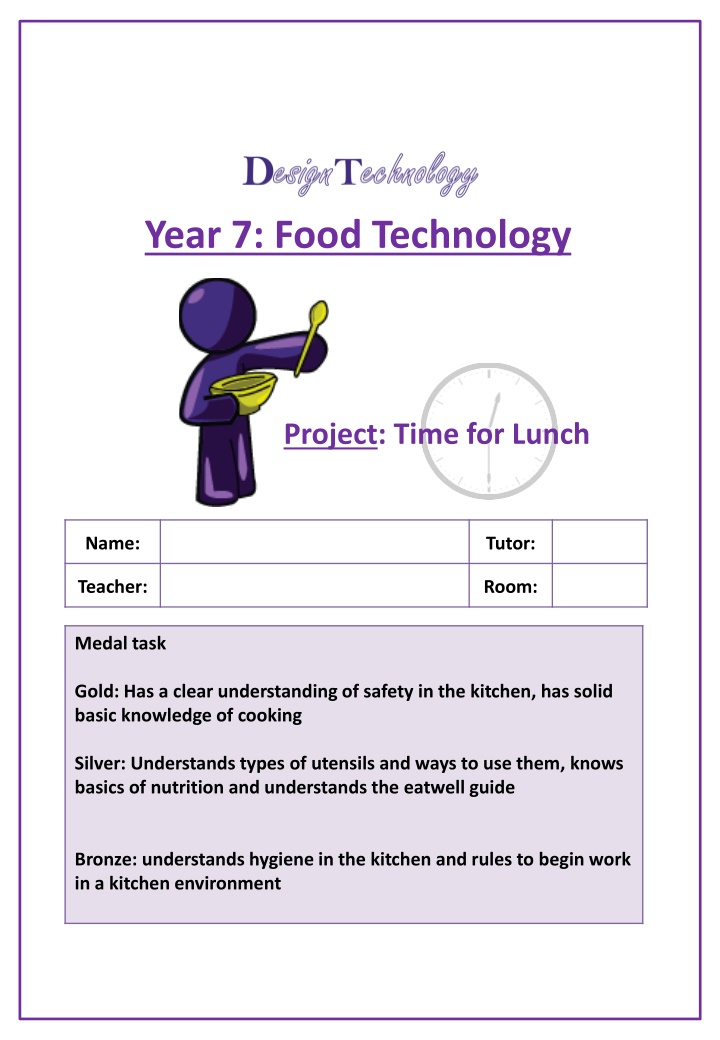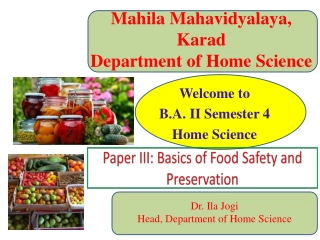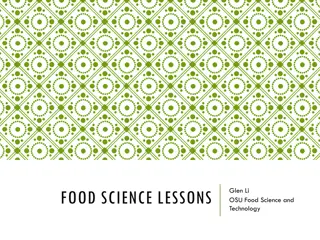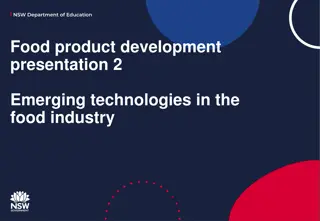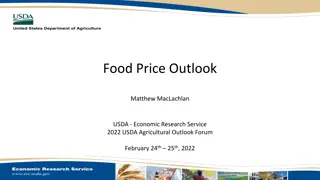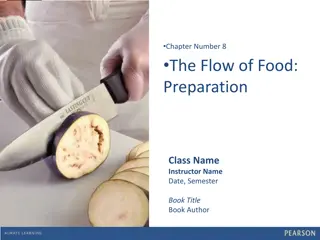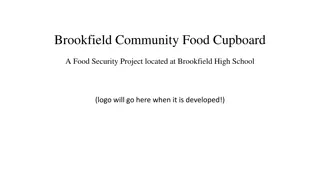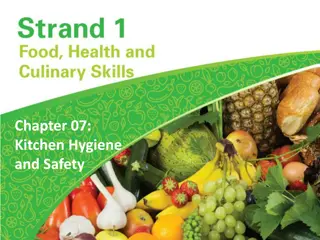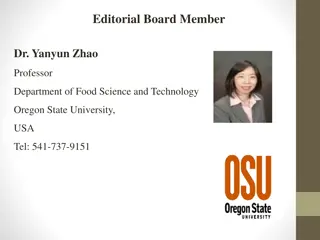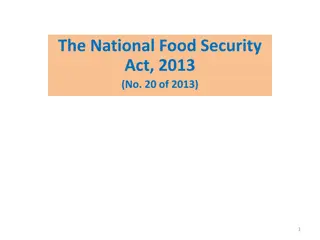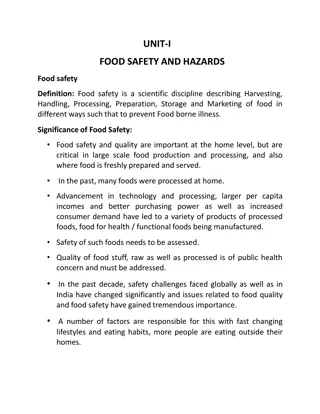Food Technology in Year 7: Practical Learning Journey
Developing basic cooking skills, nutrition awareness, and kitchen hygiene in Year 7 Food Technology through practical lessons focusing on creating lunchbox-friendly products. The project emphasizes safety, utensil usage, nutrition basics, and kitchen hygiene, with opportunities for hands-on learning and homework assignments to extend culinary knowledge beyond the classroom.
Download Presentation

Please find below an Image/Link to download the presentation.
The content on the website is provided AS IS for your information and personal use only. It may not be sold, licensed, or shared on other websites without obtaining consent from the author.If you encounter any issues during the download, it is possible that the publisher has removed the file from their server.
You are allowed to download the files provided on this website for personal or commercial use, subject to the condition that they are used lawfully. All files are the property of their respective owners.
The content on the website is provided AS IS for your information and personal use only. It may not be sold, licensed, or shared on other websites without obtaining consent from the author.
E N D
Presentation Transcript
Year 7: Food Technology http://t1.gstatic.com/images?q=tbn:ANd9GcQggI43ZsVKBYS1zcUHYlG0eYW8HuT4Bbn3Vu78rGL5zipzrdAPKAW4TRxA_A Project: Time for Lunch Name: Tutor: Teacher: Room: Medal task Gold: Has a clear understanding of safety in the kitchen, has solid basic knowledge of cooking Silver: Understands types of utensils and ways to use them, knows basics of nutrition and understands the eatwell guide Bronze: understands hygiene in the kitchen and rules to begin work in a kitchen environment
Overview of Project With a focus on products that are suitable for your lunchbox, Food Technology in year 7 looks at developing your basic cooking skills, along with your awareness of nutrition, and health, safety & hygiene in the kitchen. Practical Lessons To develop your practical skills, you will make a range of both sweet and savoury products. All of the recipe sheets for the practical lessons are at the back of this booklet. These tell you the ingredients that you will need to bring with you for each practical session. You will record the list of ingredients into your diary the week before the practical lesson so that you have plenty of time to organise them. If you keep the booklet safe when you have finished the project, you will also be able to make the products again at home . Please make sure you are organised and do not forget what you need to bring with you for each lesson! If you forget ingredients on the day of a practical and do not have a note to explain why, you will be set a 15 minute detention. If you are absent from school, please find out what you have missed and if you need to bring anything to the next lesson. Each time you have a practical lesson, you must remember to bring a suitable container to take what you have made home. Homework To extend your learning outside of school, you will be set homework once a fortnight. As part of this, you will create your own Homework Booklet having completed tasks from the Homework Menu. Please make sure that all homework is completed and handed in on time. Please also make sure that you have read instructions carefully and that work is completed to a standard that shows the best of your ability. 1. Something you ve cooked at home or primary school. --------------------------------------------------------------------------------------- 2. Name an English dish. --------------------------------------------------------------------------------------- 3. Name a piece of kitchen equipment. --------------------------------------------------------------------------------------- .
My Practical Learning Journey As you use skills again and again during practical lessons, you should become more confident and independent in the kitchen. On this page, you will keep a record of the skills that you are learning and developing. The page should be looked at after each practical. 23/09/14 12/10/14 Next to the skills you have used in the practical lesson, you should track what stage you are at. Be honest when completing the trackers so that your progress here reflects how confidently and independently you are working in class. Each time you colour in a section of the tracker, write the date above it, as shown. Weigh / Measure Ingredients Colour What does it mean? Not covered I understand some (i.e. from watching a demonstration, or from doing it previously) I understand and can do (i.e. from completing a practical) I understand and can help others (i.e. from completing more than one practical) Weigh / Measure Ingredients Assemble a Food Product Boil Use the Bridge Hold Cutting Technique Use the Hob Safely Shape Dough Use the Claw Grip Cutting Technique Use the Grill Safely Use a Cutter Cut Evenly Sized Pieces Measure Thickness of Dough Use the Oven Safely Use the Melting Method Combine Ingredients Beat Ingredients Use the Creaming Method Spread Ingredients Roll out Dough Use Finishing Techniques Form a Dough Drain Divide Mixtures Evenly Use the Rubbing-in Method Grate
Lesson Procedures: Rules and Expectations Food practical lessons can be very busy, with a lot to get done in the time limit. To ensure lessons run smoothly, please make sure you follow the following rules and procedures. Rules and expectations Before a practical lesson Bring your ingredients to the food room BEFORE the start of the day. Cold ingredients need to be stored in the fridge. Dry and ambient ingredients need to be stored on the trolley, along with your container. Your ingredients and container should be labelled with your name and tutor group. When specified and where possible, ingredients should be weighed out before coming to school, and everything should be labelled with your name and tutor group. If you are unable to weigh ingredients at home, you should come BEFORE the lesson to weigh them out, e.g. before school, at break time, or at lunch time. If you are unable to bring ingredients to school, you must come and inform me BEFORE the start of the day. You should have a note from home to explain why. At the start of a lesson Line up outside of the room sensibly and quietly. If it is a practical lesson, remove your blazer and have it ready to put in the storage unit, along with your bag. Failure to be prepared before entering the food room will delay the lesson, which may prevent you from being able to complete your practical. If it is a theory lesson, remove your coat, and get out your diary, pencil case and homework (if due in). You will place your other belongings in the storage unit when you enter the room. During a lesson You must sit in your assigned seat and work in your assigned kitchen area. It is your responsibility to ensure your area is clean and tidy at the end of the lesson, whether it is a theory or practical lesson. In practical lessons, you must only use equipment from the cupboard and drawer you have been assigned. It is your responsibility to ensure equipment is clean, dry and packed away in the right place by the end of the lesson. Sanctions will be issued to anyone who has not washed up, dried up, or cleared away their equipment properly. Please leave the room how you would expect to find it! At the end of a lesson Products can be left on the trolley or in the fridge (depending on what you have made) and collected at the end of the day. Anything that is left behind must be clearly labelled with your name and tutor group. If you choose to leave your food, you will not be allowed to collect it at break or lunch time only at the end of the day. If any containers, ingredients, etc. are left behind after a lesson and not collected the next day, they will be thrown away. Student Contract I, ____________________________________, agree to follow the rules and procedures outlined above. I understand that failing to follow these rules and procedures will result in sanctions. Signed: _ _______________________________________ Date: _________________________
Food Vocab Bank Any spelling errors in your work must be recorded in this table with the correct spelling. Don t forget to check back over your work to make sure that you are spelling key words correctly. Power of 3 1. The most unusual dish you have eaten. --------------------------------------------------------------------------------------- 2. Name a knife hold. ---------------------------------------------------------------------------------------- 3. Write down an important safety point for using knives -----------------------------------------------------------------------------------------
WASHING UP Wipe out the sink and rinse Put the plug in. Add some washing up liquid right under where the water is going to hit. About two teaspoons, the amount needed varies with the brand and the dish pan size. You're aiming for just enough soap to cause suds to cover the top of the water. Fill the sink about 1/3 with bath temperature water. You want hot water, because hot water cuts oils. Dish cloth - This is the traditional tool. They are good for wiping down counters, and you can use them to wash dishes. They have some limitations. Because they are absorbent, germs grow on them if you aren't careful. You need to wash them out with soap after each use, Green scrubber pad - These are my favourite for dish washing. They scrub well, dry quickly, and don't get too much food stuck in them. BE CAREFUL OF ANYTHING WITH A METAL CUTTING EDGE - Don't ever drop these things into the soapy water. You can dunk them, but don't let go. This is so they don't rust, but also, so they don't cut your hands up.
Health and Safety in the Kitchen Today s Learning Objectives: (Tick each objective once you think you have met it during the lesson) To understand hazards and risks that may occur in a kitchen To understand the importance of following health, safety and hygiene procedures when working with food The Food Technology classroom is one of the most dangerous rooms in the school. During practical lessons, you will be using a range of equipment, such as sharp knives, ovens, and the hob. It is therefore really important that you follow strict health and safety rules to reduce the risk of accidents and injuries. TASK: Look at the picture below and circle the hazards in the kitchen area. Why is it important to follow health and safety rules in the kitchen? __________________________________________________________________________________ __________________________________________________________________________________ __________________________________________________________________________________ __________________________________________________________________________________ List 4 ways that the kitchen area above could be made safer. _____________________________________________________________________________ _____________________________________________________________________________ _____________________________________________________________________________ _____________________________________________________________________________
Hygiene and Lesson Procedures Good hygiene is VERY important when working with food. Poor hygiene can lead to the contamination of food, which can result in food poisoning. There are two types of hygiene that you will need to think about carefully during practical food lessons in school, and when preparing, making, cooking, and storing food outside of school. These are Personal Hygiene and Food Hygiene. Personal Hygiene is about caring for your body by keeping it clean and healthy. TASK: On the person, identify 5 things you should do to prepare yourself for a food practical to ensure that you work hygienically. Can you also explain why? http://t3.gstatic.com/images?q=tbn:ANd9GcTUkiBmBnW-yiVzujjJluhhS9R0sLkZph-7NcI41rpMamX2X6Gm2VEgRAU http://t2.gstatic.com/images?q=tbn:ANd9GcSa9g-hE9gBx4Fb0A3E1aPM_XzTV4r-ZqOP2yMDRZo2YO1b7ly7BQhfig http://t1.gstatic.com/images?q=tbn:ANd9GcR8nmSuXpTwOlraleTpG8y6gl8n3hn51DcMY432Zk49TYsqkgo-Ff0E404 When working with food, cuts must be covered with a __________ plaster because ______________ __________________________________________________________________________________ Food Hygiene refers to the rules followed when handling, cooking and storing food to prevent food poisoning. The 4Cs for food hygiene tell us what we must do to ensure that food is safe to eat. TASK: Name 4 hygiene rules in the kitchen? _____________________________________________________________________________ _____________________________________________________________________________ _____________________________________________________________________________ _________________________________________________________________________
Healthy Eating Today s Learning Objectives: (Tick each objective once you think you have met it during the lesson) To understand what a balanced diet is. To be able to identify the five key nutrients. On a daily basis, it is important that we eat the right types of foods and in the right quantities to enable us to stay healthy. As well as eating healthily, we should also do regular exercise to help us stay fit. If we don t, health conditions can impact our lives. What health conditions can having a poor diet cause / contribute to? ________________________ __________________________________________________________________________________ __________________________________________________________________________________ The Eatwell Plate shows us what we should eat to have a well-balanced and healthy diet. The different sections of the Eatwell Plate represent different types and proportions of food. Getting the balance right every day will mean your diet is healthy. TASK: Fill in the Eatwell Plate below using the assessment criteria to help you. Assessment Criteria Checklist L3 Correctly render and label the sections of the Eatwell Plate. L4 Write or draw relevant examples of food products for each section. L5 Label the nutrient that each section provides. L6 Suggest the function that each of the nutrients performs in the body. Teacher Feedback Student Comments WWW: After reading my teacher s comments I have improved my work by EBI: Level after Response to Feedback:
Nutrients All foods are made up of chemical substances called nutrients. Nutrients are needed by the body to perform different functions. The five key nutrients are Carbohydrate, Fat, Protein, Vitamins and Minerals. You can remember these by using your hand. TASK: Draw round your hand in the space below, and label your thumb and fingers as different nutrients. Can you also label what functions the different nutrients perform in the body? Assessment Criteria Checklist Have you drawn in pencil? Have you named the 5 nutrients? Have you checked your spellings? Have you added colour? Have you labelled the functions of the nutrients? Have you checked spellings and grammar? 1. What is this vegetable called? -------------------------------------------------------------------------- 2. Why do we tie our hair back? (give two reasons) -------------------------------------------------------------------------- 3. Where should you store raw chicken? Power of 3 -------------------------------------------------------------------------- Example of Foods Nutrient Eatwell Plate Sections Protein Carbohydrate Fats Vitamins TASK: In the table below, link each nutrient to the relevant section of the Eatwell Plate, and provide an example of a food that is high in that nutrient. Minerals
Power of 3 1 name an Italian dish? --------------------------------------------------------------------------------------------------- 2 what colour board would you use for preparing a carrot for coleslaw? --------------------------------------------------------------------------------------------------- 3 what is the safe cooking temperature? ---------------------------------------------------------------------------------------------------- Task: complete medal task Gold: Complete all tasks up to this point in your book Silver: understand nutrition and the Eatwell guide Bronze: show a good understanding of personal hygiene in the kitchen Level up:
Weighing and Measuring Today s Learning Objectives: (Tick each objective once you think you have met it during the lesson) To understand what equipment can be used to weigh and measure ingredients. To be able to weigh and measure ingredients accurately. When making food products, it is really important to weigh and measure ingredients accurately. If ingredients are not weighed or measured accurately, the product that you make may not taste, smell, look or feel right. A number of pieces of equipment can be used to weigh and measure ingredients. TASK: Name each of the following pieces of equipment and suggest what ingredients they may be used to measure, giving specific examples. Name of Equipment Used to Measure Unit (e.g. grams, etc.) Accuracy Tests To help you to develop your weighing and measuring skills, you are going to complete a set of accuracy tests. In the space below, describe what tests you completed and name the equipment that you used. A peer or teacher should verify that you completed each test by initialling the final column. Measure Description of Test Completed Verified Test 1 50g rice Using scales complete the task 100ml water Test 2 Use a jug to achieve this task Test 3 Demonstrate how to set scales to zero Using an empty bowl show how you reset a scale to 0
http://t2.gstatic.com/images?q=tbn:ANd9GcT4ug1e2-wUuZ6JVUxBSNnocHBhUD_iDuTsDZ1CeVEc9adgUXPAAmcEc2khttp://t2.gstatic.com/images?q=tbn:ANd9GcT4ug1e2-wUuZ6JVUxBSNnocHBhUD_iDuTsDZ1CeVEc9adgUXPAAmcEc2k http://t0.gstatic.com/images?q=tbn:ANd9GcRjbaM7u5XEIgyv_6kplrIpLPy1WRk_2TskI5bL8mvxFaCmvPPf9xqEVZrs Pastry Today s Learning Objectives: (Tick each objective once you think you have met it during the lesson) To be able to identify products made using pastry. To understand the process of making shortcrust pastry. Different types of pastry can be used to make different food products. TASK:Identify four different types of pastry, and suggest examples of food products that each one is used to make. ___________________________, which is used for ____________________________________ ___________________________, which is used for ____________________________________ ___________________________, which is used for ____________________________________ ___________________________, which is used for ____________________________________ What ingredients are used to make shortcrust pastry? Can you explain why they are used? __________________________________________________________________________________ __________________________________________________________________________________ __________________________________________________________________________________ What is the general rule in terms of quantities of key ingredients used to make shortcrust pastry? __________________________________________________________________________________ __________________________________________________________________________________ How much fat would you need to make a batch of pastry if you have 200g flour? _______________ How much flour would you need to make a batch of pastry if you have 150g fat? _______________ What skills and techniques are used to make shortcrust pastry? __________________________________________________________________________________ __________________________________________________________________________________ __________________________________________________________________________________ __________________________________________________________________________________ Pastry is a versatile product and can be used to make a number of foods. It is, however, high in fat. How could you make the nutritional value of pastry products healthier? __________________________________________________________________________________ __________________________________________________________________________________ __________________________________________________________________________________ __________________________________________________________________________________
Savoury Tart Design Ideas Today s Learning Objectives: (Tick each objective once you think you have met it during the lesson) To be able to consider appropriate ingredients to add to a savoury tart. To demonstrate an understanding of how to design a savoury tart considering sensory features. TASK: Develop a spider diagram to consider ingredients that you could add to your savoury tarts. Think about whether each one will add flavour / colour / texture. TASK: Draw a clear and detailed diagram of your chosen design, and annotate it clearly to show the ingredients used. Assessment Criteria Checklist L3 - Draw a neat diagram of your tart using pencil, and render it using colouring pencils. Label the additional ingredients. L4 - Explain why you have chosen the additional ingredients based on their sensory features, e.g. to add a crunchy texture. Use the Sensory Analysis Word Bank. L5 - Identify the nutrients provided by the additional ingredients. Label the other ingredients used to make the savoury tart. L6 - Explain the functions of the nutrients identified. Explain what processes and techniques would be used to make the savoury tart. Power of 3 1 what are the first three things you do when you get to the kitchen, preparing to cook? 2 what colour board would you use to make a cheese sandwich? 3 give one example of a food high in vitamin c
Cake-Making Today s Learning Objectives: (Tick each objective once you think you have met it during the lesson) To understand the ingredients and methods used to make cake. To be able to modify/change a basic cake recipe to make it healthier. The four main ingredients used to make cakes are: http://t3.gstatic.com/images?q=tbn:ANd9GcTyyjQRiVicP10Bh_cb6ZqFH8ejFuEZw0A8wJ3Iiy8Pg7ng0nmOs6TB8g http://t1.gstatic.com/images?q=tbn:ANd9GcSW_I9q23EsVG8LWnxqlNFmfEAMXkPaYZiceMsvVg0CwpAnTB9lIMOEFO7Y http://t0.gstatic.com/images?q=tbn:ANd9GcRXpjM_AElJ9FGFDRqsvDXLMTDuFjesQBoF0sYwde_FWQ8QQFyBilQ9jZA http://t2.gstatic.com/images?q=tbn:ANd9GcS0QQMfwdVpOdK98JIafhpT48cP1HQ_Fm0yNQ0NUryScIR7MyRMY8Iir_EQlg _______________ _______________ _______________ _______________ The four different cake-making methods are: 1. _____________________________________ 3. _____________________________________ 2. _____________________________________ 4. _____________________________________ TASK: Next lesson you will use the creaming method to make a batch of cakes. You should make the cakes healthier by modifying the original cake recipe. In the space below, draw and annotate a clear and detailed diagram of your chosen cake design. Assessment Criteria Checklist L3 - Draw a neat diagram of your cake using pencil, and render it using colouring pencils. Label the additional ingredients. L4 - Explain why you have chosen the additional ingredients based on their sensory features, e.g. to add a crunchy texture. Use the Sensory Analysis Word Bank. L5 - Identify the nutrients provided by the additional ingredients. Label the other ingredients used to make the cake. L6 - Explain the functions of the nutrients identified. Explain what processes and techniques would be used to make the cake. Basic Recipe: 100g self-raising flour 100g caster sugar 100g fat 2 eggs 1 name the vitamin mostly found in fruit and vegetables. 2 what chopping board would you use for chopping a banana? 3 name a knife hold.
Handheld Lunch Products: Design Ideas Part 1 Today s Learning Objectives: (Tick each objective once you think you have met it during the lesson) To understand what a handheld product is. To be able to develop design ideas to meet a design brief and specification criteria. Context Sainsbury s is looking to extend the range of handheld lunch products that they sell. They would like you to develop some design ideas for new products, which would be suitable for primary school children. Design Brief Using the work you have completed within Food Technology to inspire you, you must develop a range of handheld products that would be suitable for a primary school student s lunchbox. You will make one of your design ideas. Specification Criteria Products must: Be handheld, and able to be eaten without cutlery. Be colourful and appealing to primary school children Be nutritious and well balanced, taking the Eatwell Plate into consideration TASK: In the space below, develop a mind map to explore ideas for products that you could design. Power of 3 1 why do we wash our hands and tie our hair back in cookery? 2 when washing up, why is it important to use warm water? 3 what does baking mean?
Handheld Lunch Products: Design Ideas Part 2 Medal Tasks: Gold: Has completed all work identifying types of cakes and sponges Silver: Understands types of lunch products and identifies if they are healthy Bronze: has completed research for tart design Draw and annotate your design ideas in the space below, using the level criteria to help you.
Handheld Lunch Products: Practical Plan Name of Product: ___________________________________________________________________ Ingredients: What will you use? Equipment Needed: What will you use? ______________________________________ _____________________________________ ______________________________________ ______________________________________ ______________________________________ ______________________________________ ______________________________________ ______________________________________ ______________________________________ ______________________________________ ______________________________________ ______________________________________ ______________________________________ ______________________________________ ______________________________________ ______________________________________ Method: How will you make your chosen product? What stages will you work through? _________________________________________________________________________________ _________________________________________________________________________________ _________________________________________________________________________________ _________________________________________________________________________________ _________________________________________________________________________________ _________________________________________________________________________________ _________________________________________________________________________________ _________________________________________________________________________________ _________________________________________________________________________________ _________________________________________________________________________________ _________________________________________________________________________________ _________________________________________________________________________________ _________________________________________________________________________________ _________________________________________________________________________________ http://www.psdgraphics.com/wp-content/uploads/2009/04/sticky-notes.jpg Health, Safety and Hygiene Measures: _____________________________________________________ _____________________________________________________ _____________________________________________________ _____________________________________________________ _____________________________________________________
Handheld Lunch Products: Evaluation Now that you have successfully designed and made your very own handheld lunch product, answer the questions below to evaluate your outcome and performance. Assessment Criteria Checklist L3 All questions are answered. L4 Answers are written in full sentences and explained in detail L5 Specific examples are provided where possible to justify answers. L6 Skills and techniques are referred to where possible. There are no errors with spelling/grammar. Name of product: _____________________________________________ What inspired this product? ____________________________________________________________ ____________________________________________________________ How is your product suitable for primary school children? ____________________________________________________________ ____________________________________________________________ What went well during the practical? __________________________________________________________________________________ __________________________________________________________________________________ __________________________________________________________________________________ What challenges did you face, and how did you overcome them? __________________________________________________________________________________ __________________________________________________________________________________ __________________________________________________________________________________ What feedback did you receive about your product and who from? __________________________________________________________________________________ __________________________________________________________________________________ __________________________________________________________________________________ http://www.psdgraphics.com/wp-content/uploads/2009/04/sticky-notes.jpg If you made the product again, what would you do differently? _____________________________________________________ _____________________________________________________ _____________________________________________________ What five sensory words would you use to describe your product? _______________________________________________________ _______________________________________________________
Fruit and Vegetables Can you name all of the different types of fruit and vegetables below?
http://t0.gstatic.com/images?q=tbn:ANd9GcQb2wxS3NdNI5ZK8DPUToLTjTL6UlIUojG0CuDM1aiY7-iGr8hyQ5ibrAsEhttp://t0.gstatic.com/images?q=tbn:ANd9GcQb2wxS3NdNI5ZK8DPUToLTjTL6UlIUojG0CuDM1aiY7-iGr8hyQ5ibrAsE Use this word bank when talking about the sensory qualities of food! http://t0.gstatic.com/images?q=tbn:ANd9GcTt3j27l5Td5eCx6QmGRqNJWzXUYlH4dqWNosTx_kq7ZEFK0duBv7YvW8GZgQ http://t0.gstatic.com/images?q=tbn:ANd9GcSOMv8OXQf9BiWmFo02MBwrTuuOmysTpGijgGQeUQmQpelOoIb4b-HhOg0 Sensory Analysis Word Bank Appearance What does the food look like? Appetising Attractive Bubbly Clear Cloudy Coarse Colourful Colourless Crumbly Dry Firm Fibrous Flat Foamy Fresh Glossy Golden Grained Greasy Healthy Hot Lumpy Mashed Minced Moist Powdery Risen Shaped Shiny Slimy Smooth Soggy Solid Stringy Syrupy Tasty Thick Watery Smell / Aroma What aroma is most noticeable? Baked Burnt Buttery Caramelised Citrus Fresh Fried Garlicky Herby Malty Meaty Pungent Savoury Spicy Sweet Texture / Mouthfeel What does the food feel like to touch / eat? Bouncy Bubbly Chewy Crispy Crumbly Crunchy Doughy Dry Firm Fizzy Flaky Foamy Gooey Greasy Gritty Hard Juicy Lumpy Moist Mushy Powdery Rough Rubbery Slimy Smooth Soft Soggy Spongy Springy Sticky Stiff Stretchy Stringy Tender Thick Thin Watery Waxy Taste / Flavour How does the food taste? Acidic Aftertaste Artificial Bitter Bland Burnt Buttery Caramelised Creamy Dry Fatty Fresh Fruity Herby Meaty Metallic Old Processed Salty Savoury Sharp Sickly Soggy Sour Spicy Stale Stewed Succulent Sweet Tasteless Tart Tasty Tangy Undercooked Watery Weak
Practical 1: Fruit Salad Ingredients: 4-6 pieces of fruit, with at least 3 that need preparing 1 carton (250ml) of fruit juice (e.g. apple, orange, pineapple) Skills Shown Bridge hold cutting technique Claw grip cutting technique Equipment: Chopping Board Sharp Knife Mixing Bowl (for food waste) Tablespoon Container Even cutting (bite size pieces) Combining ingredients REMINDER: Complete the My Practical Learning Journey page for skills used. Method: 1. Prepare yourself and your equipment. 2. Wash (if necessary) and prepare your fruit using the appropriate cutting techniques. Put food waste into the large mixing bowl and fruit into your container as you go. 3. Add your fruit juice to your container and stir the fruit salad using a tablespoon to ensure all fruit is evenly distributed. 4. When finished, wash up your equipment and clean your work areas. Evaluation: What fruit did you choose to add to your fruit salad? __________________________________________________________________________________ __________________________________________________________________________________ What went well during the practical? __________________________________________________________________________________ __________________________________________________________________________________ What challenges did you face? How did you overcome them? __________________________________________________________________________________ __________________________________________________________________________________ __________________________________________________________________________________ What would you do differently if you made the fruit salad again? http://www.psdgraphics.com/wp-content/uploads/2009/04/sticky-notes.jpg _____________________________________________________ _____________________________________________________ _____________________________________________________ Sensory Analysis - Choose 3 words to describe your fruit salad using the Sensory Analysis Word Bank. ______________________________________________________
Practical 2: Healthy Pizza Bread Ingredients: Small Baguette / Baton / Ciabatta / Flatbread 4-5 tablespoons tomato puree 200g cheese (e.g. cheddar, Red Leicester, etc.) Your choice of well balanced toppings Skills Shown Bridge hold cutting technique Claw grip cutting technique Even cutting (bite size pieces) Equipment: Chopping Board Sharp Knife Grater Mixing Bowl (for food waste) Table Knife Grill Pan Spreading Grating Assembling a food product Using the grill REMINDER: Complete the My Practical Learning Journey page for skills used. Method: 1. Prepare yourself and your equipment. 2. If necessary, cut your bread in half and place it on a grill pan. 3. Prepare your toppings. 4. Spread your tomato puree onto the bread. Then add your toppings, ensuring they are evenly distributed. 5. Place your bread under the grill, and turn the grill onto a high heat. Cook your pizza bread for approximately 5 minutes, or until the cheese is melted and slightly golden. Remove your pizza bread from the grill using oven gloves and enjoy! 6. When finished, wash up your equipment and clean your work areas. Evaluation: How did you make your pizza bread well balanced? __________________________________________________________________________________ __________________________________________________________________________________ What went well during the practical? __________________________________________________________________________________ __________________________________________________________________________________ What problems did you encounter? How did you overcome them? __________________________________________________________________________________ http://www.psdgraphics.com/wp-content/uploads/2009/04/sticky-notes.jpg ____________________________________________________ ____________________________________________________ Sensory Analysis - Choose 3 words to describe your pizza bread using the Sensory Analysis Word Bank. ______________________________________________________
Practical 3: Pasta Salad Ingredients: 100g pasta 2-4 vegetables (e.g. spring onion, red onion, tomato, etc.) A source of protein (e.g. cooked meat, cheese, etc.) 2-3 tablespoons salad dressing Skills Shown Weighing / measuring Using the hob Bridge hold cutting technique Equipment: Large Saucepan Wooden Spoon Chopping Board Sharp Knife Mixing Bowl Tablespoon Colander Container Claw grip cutting technique Even cutting (bite size pieces) Combining ingredients REMINDER: Complete the My Practical Learning Journey page for skills used. Method: 1. Prepare yourself and your equipment. 2. Half fill a large saucepan with cold water, and put it on the hob on a high heat to bring it to the boil. Wait for the water to reach boiling point before adding your pasta. 3. Meanwhile, prepare the ingredients you are adding to your pasta salad, and add them to a mixing bowl. 4. When your pasta is cooked, drain it over the sink using a colander, and run it under cold water until it has cooled down. 5. Add the pasta to the mixing bowl with your other ingredients. Then add your salad dressing and mix all of the ingredients together. 6. When finished, wash up your equipment and clean your work areas. Recipe Modifications: What is your pasta salad going to include? __________________________________________________________________________________ __________________________________________________________________________________ __________________________________________________________________________________ How well balanced is your pasta salad design? Why? __________________________________________________________________________________ __________________________________________________________________________________ http://www.psdgraphics.com/wp-content/uploads/2009/04/sticky-notes.jpg _____________________________________________________ How could you make it even healthier? ______________________________________________________ ______________________________________________________ ______________________________________________________
Practical 4: bean chilli Ingredients : can beans onion 1/2 tsp oil 1.4 can chopped tomatoes 1 tsp chilli spice mix 1 tbsp. ketchup Salt and pepper Skills Shown Weighing / measuring Using the hob Stirring and mixing Combining ingredients Careful seasoning Equipment: Knife Brown chopping board Saucepan Wooden spoon Measuring spoons simmering REMINDER: Complete the My Practical Learning Journey page for skills used. Method: 1. Cut the onion into small dice 2. Put in a pan with the oil and cook on a low heat for 2 minutes 3. Add chilli spice mix, stir and cook for 1 minute 4. Add the rest of the ingredients and simmer for 5 10 minutes. 5. Season to taste. Recipe Modifications: __________________________________________________________________________________ __________________________________________________________________________________ How will these ingredients improve the nutritional value of your chilli? __________________________________________________________________________________ __________________________________________________________________________________ _____________________________________________________ How else could you modify/change this recipe? ______________________________________________________ ______________________________________________________ ______________________________________________________ http://www.psdgraphics.com/wp-content/uploads/2009/04/sticky-notes.jpg
Practical 6: Savoury Tarts Ingredients (for 12 tarts): For the Pastry 200g plain flour 100g fat 2 tablespoons cold water For the Filling 2-3 ingredients of your choice 1 egg 75ml milk Skills Shown Weighing ingredients Rubbing in Combining ingredients Rolling Out Measuring thickness Cutting Equipment: Large mixing bowl Jug Tablespoon Palette Knife Rolling Pin Cutter Fork Bun / Muffin Tin Beating Use of the oven Make a note of any additional skills you use REMINDER: Complete the My Practical Learning Journey page for skills used. Method: 1. Prepare yourself and your equipment. Pre-heat your oven to 200 C. 2. In a bowl, rub the fat into the flour until the mixture resembles breadcrumbs. 3. Make a well in the centre of the breadcrumb mixture and add the cold water. Use a palette knife to mix it through. 4. Bring the dough together with your hands. If a dough does not form, gradually add a little more water and repeat the step. 5. Transfer the dough to a lightly floured surface, and roll it out to the thickness of a 2 pence coin using a rolling pin. 6. Cut out the dough using a cutter, and place the pastry circles in a bun / muffin tin. 7. In a jug, beat the egg and milk together using a fork. 8. Add your additional ingredients to the tart cases. Then carefully pour the egg/milk mixture over the top. 9. Place the tarts in the oven for 10-15 minutes. When cooked and slightly golden, remove them from the oven and allow to cool. 10. When your tarts are cooking, wash up your equipment and clean your work areas. Recipe Modifications: What additional ingredients are you going to add to your savoury tarts? Why? http://www.psdgraphics.com/wp-content/uploads/2009/04/sticky-notes.jpg _____________________________________________________ _____________________________________________________ _____________________________________________________ _____________________________________________________ _____________________________________________________ _____________________________________________________
Practical 7: Fruity Cakes Ingredients (for 12 cakes): 100g self-raising flour 100g caster sugar 100g fat 2 eggs 2-3 additional ingredients of your choice to add flavour and to make your cakes healthier (e.g. blueberries and lemon) Skills Shown Weighing / Measuring Creaming Method Combining ingredients Beating Even dividing of mixture Equipment: Bun Tin 12 Fairy Cake Cases Large mixing bowl Wooden Spoon Sieve Jug Fork Tablespoon Teaspoon Use of the oven Make a note of any additional skills that you use REMINDER: Complete the My Practical Learning Journey page for skills used. Method: 1. Prepare yourself and your equipment. Pre-heat your oven to 180 C. Place your cake cases in a bun tin. 2. Place your fat and caster sugar in a bowl, and beat with a wooden spoon until light and fluffy. 3. Crack both of your eggs into a jug and beat with a fork. 4. Gradually add the egg to the bowl, and beat it in using the wooden spoon. 5. Sift in your self-raising flour, and mix through until a smooth batter is achieved. 6. Add your additional ingredients to the mixture, e.g. fruit, and stir through. 7. Spoon the mixture into the cake cases. For this, use a tablespoon to get the mixture out of the bowl and a teaspoon to scrape it off the tablespoon into the cake case. 8. Place the cakes in the oven for 10-12 minutes, until they are risen and golden brown. 9. When your cakes are cooking, get all of your washing up done. Evaluation: What additional ingredients did you choose to add to your cakes? Why? __________________________________________________________________________________ __________________________________________________________________________________ What would you do differently if you made the cakes again? http://www.psdgraphics.com/wp-content/uploads/2009/04/sticky-notes.jpg _____________________________________________________ _____________________________________________________ Sensory Analysis - Choose 3 words to describe your cakes using the Sensory Analysis Word Bank. ______________________________________________________
Level up task: Overall assessment of medal task: Gold: Has a clear understanding of all the recipes and ways to develop them to be healthy Silver: Understands basic food healthy choices and researches Bronze: completed all recipes to a adequate standard identifying hygiene
NOTES P OF 3 - RECIPE NOTES - OTHE RTHINGS
End of Project Self Assessment Complete the following self-assessment to help you reflect on how well you have worked in Food Technology. Tick the appropriate face for each of the statements. Yes Maybe No Organisation I came to practical lessons ready to cook and prepared with the necessary ingredients. I worked well throughout practical lessons and kept my work area tidy. I managed my time effectively and completed all of the tasks set each lesson. I listened to instructions and followed them carefully in all lessons. Hygiene and Safety I wore an apron, tied my hair back (if necessary) and removed jewellery at the start of practical lessons. I washed my hands before and during practical lessons. I cleaned my area, washed up, and cleared away properly after each practical lesson. I used the oven/grill safely, and used oven gloves to place items into and remove items from the oven/grill. I used the hob safely, and remembered how to position saucepans safely (handles turned in). I used sharp knives safely with the correct cutting techniques. Food Preparation and Making Skills I followed recipes accurately. I measured and weighed ingredients accurately using the appropriate equipment, e.g. measuring jug, weighing scales. I used a range of basic equipment. I know what the bridge hold and claw grip cutting techniques are, and can use them accurately. I used different techniques when making food, e.g. the rubbing-in method when making scones. Evaluating When evaluating products, I used sensory analysis terminology. When asked to do so, I evaluated practical lessons in detail, and thought about what went well and what I could do to improve products / my performance. Targets Based on the Food Technology module, what do you hope to improve during the next D&T module? _________________________________________________________________________________ _________________________________________________________________________________
End of Project Survey Please complete the following survey to let us know what you think about the food technology module you have just completed. Read the statements in the table below, and then tick the relevant box to show if you strongly agree, agree, disagree, or strongly disagree with it. Strongly Agree Agree Disagree Strongly Disagree Lessons were enjoyable. The booklet was easy to complete. I understood what I had to do in all of the lessons. The classroom environment was managed safely. I have developed basic cooking skills. I have developed a good understanding of nutrition. My teacher provided useful feedback to help me achieve my potential. I know my target level. I know what I need to do to meet my target level. I enjoyed being able to choose my homework from the Homework Menu. Homework Tasks were easy to understand. Homework Tasks were enjoyable to complete. In the table below, choose the most appropriate smiley face to rate the practical lessons you completed. Mark your answers by ticking the relevant box. Practical not completed. Like Neutral Dislike Fruit Salad Healthy Pizza Bread Pasta Salad Healthy Flapjack Savoury Scones Savoury Tarts Fruity Cakes Handheld Lunch Product How could year 7 Food Technology be improved? __________________________________________________________________________________ __________________________________________________________________________________ __________________________________________________________________________________
Environmental impacts around the world Complete a poster of plastics, how this is effecting the planet, what we can do to help it, research what is being done now and in the future Complete a spider graph of ideas on how you will complete your homework
